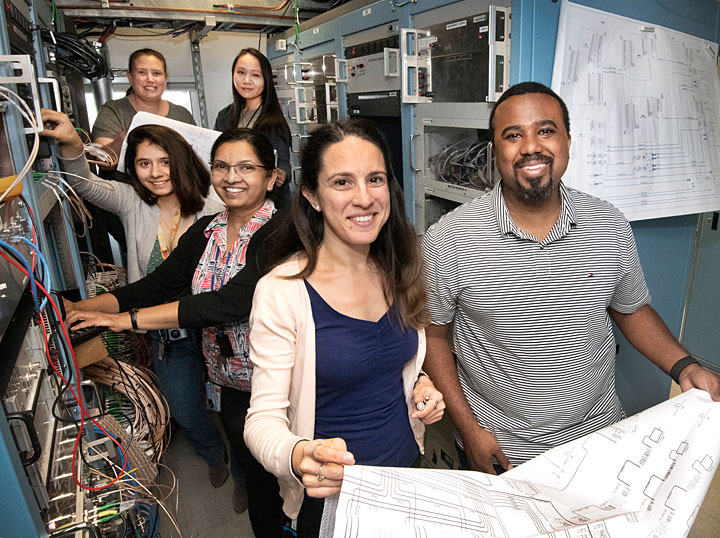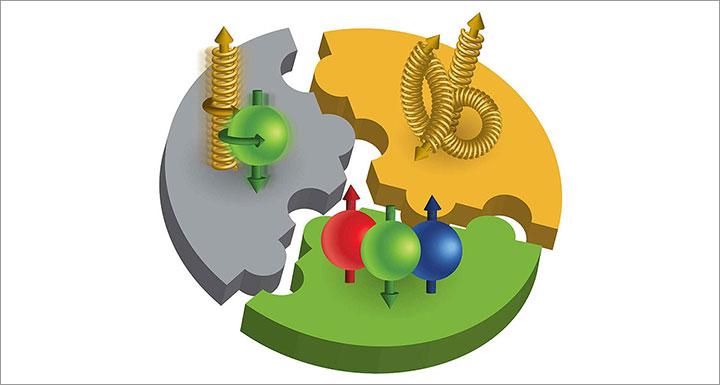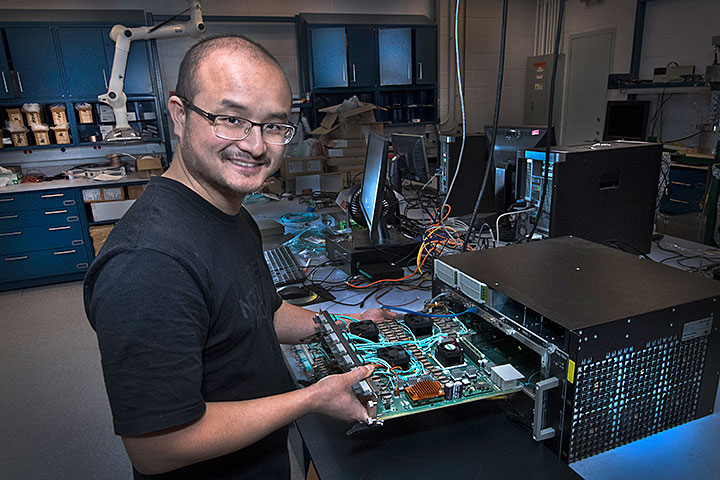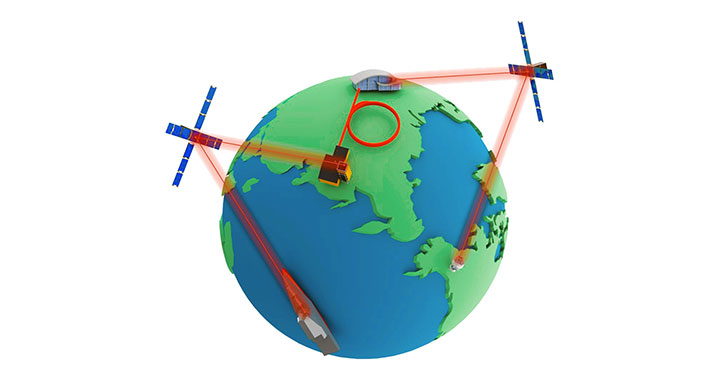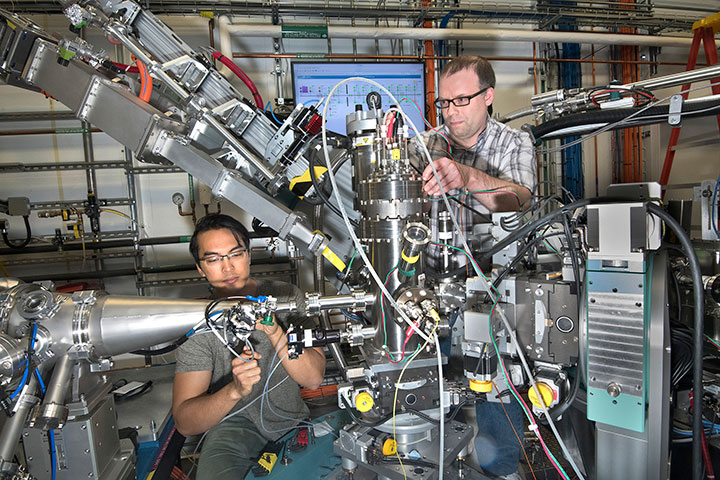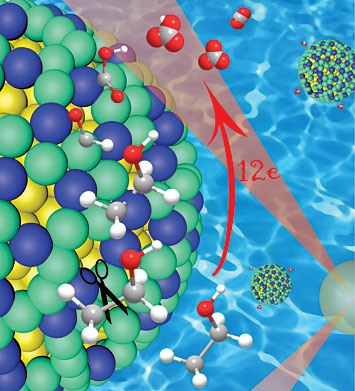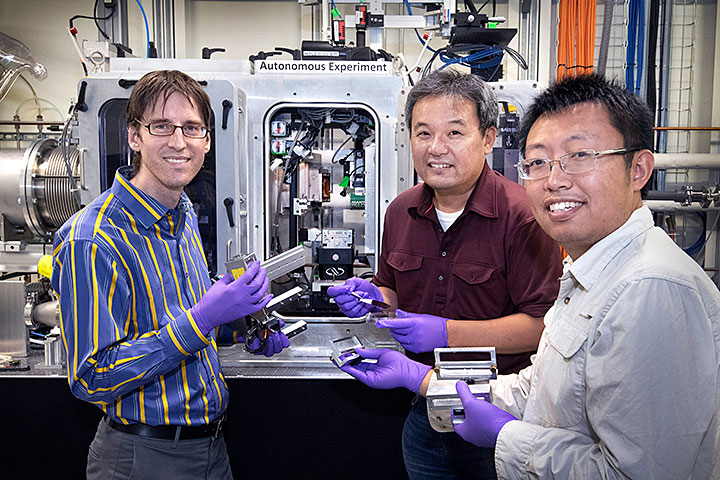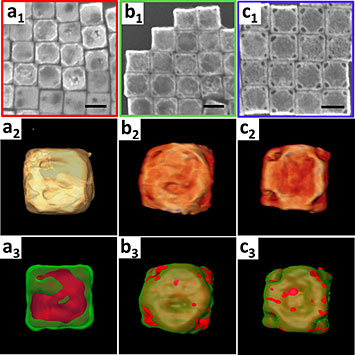Top-10 Science and Technology Achievements of 2019
January 6, 2020
UPTON, NY—In 2019, scientists at the U.S. Department of Energy’s (DOE) Brookhaven National Laboratory dove deeper into proton spin, took a leap in quantum communication, and uncovered new details of plant biochemistry, battery cathodes, catalysts, superconductors, and more. Here, in no particular order, are the biggest advances of the year.
World’s First ‘Bunched-beam’ Electron Cooling at Collider
Accelerator physicists and engineers at the Relativistic Heavy Ion Collider (RHIC) demonstrated a groundbreaking technique that uses bunches of electrons to cool beams of particles at RHIC. This “bunched-beam” electron cooling system is designed to keep RHIC’s circulating particles tightly packed, particularly at low energies, increasing the likelihood that the particles will collide. Such cooling is essential for producing data over a wide range of collision energies so nuclear physicists can explore how the building blocks of matter that filled the early universe transformed into the ordinary matter of today’s world. The technique required a series of “world’s-first” accelerator advances, fully implemented at RHIC for this year’s run.
Sea Quark Surprise Reveals Deeper Complexity in Proton Spin Puzzle
Nuclear physicists from the STAR collaboration at the Relativistic Heavy Ion Collider (RHIC) discovered quirky new information about how particles called antiquarks contribute to proton spin. Proton spin is the property that makes MRI scans possible, but its origin is a perplexing puzzle. The new results reveal that antiquarks contribute to spin differently depending on their “flavor,” with less-abundant “up” antiquarks making a larger contribution to the spin than the more-abundant “down” antiquarks. These counterintuitive findings offer fresh insight into the quantum complexity within the proton.
Equipment Delivered for Global High-energy Physics Experiments
Scientists, engineers, and technicians at Brookhaven Lab finished constructing the 3.2 gigapixel sensor array for the Large Synoptic Survey Telescope, a massive telescope that will observe the universe like never before. The sensor array, which took 16 years to design and build, is the biggest charge-coupled device (CCD) array that has ever been built, and it will enable scientists to create a time-lapse movie of the universe. Brookhaven also coordinated the completion of major upgrades to the ATLAS Experiment at CERN’s Large Hadron Collider. The project focused on three components of ATLAS—the trigger/data acquisition system, the liquid argon calorimeter, and the forward muon detector—and will provide scientists with the ability to gather data more efficiently and at higher collection rates.
Going the Distance for Quantum
Scientists from Brookhaven Lab’s Computational Science Initiative, Instrumentation Division, and Physics Department and Stony Brook University (SBU) have entered the technological race to develop the quantum internet. Based on the extraordinary phenomena of quantum physics, such a network could revolutionize the way we communicate and compute. The team has completed the first leg of the race, building a quantum network testbed using “entangled” photons—particles of light whose properties are intertwined, even when those particles are separated by vast distances—to connect several buildings on the Brookhaven campus.
Understanding Thin Films for Future Applications
Scientists at the National Synchrotron Light Source II (NSLS-II) used ultrabright x-rays to visualize and understand the growth and assembly of thin films. Thin films dominate some of the most important technologies in our daily lives, such as computer chips and solar cells. In one study, scientists demonstrated a new ability to watch these thin films grow on imperfect substrates. By watching them grow, scientists can understand how these materials are formed, gaining insights about their properties and potential applications— for example, in organic solar cells. A second study explored a new approach using heat to drive a spontaneous process in which different metals form 3-D interlocking nanostructures in thin films. These sponge-like structures could be useful in catalysis, energy generation and storage, and biomedical sensors.
Advances in Catalysts for Energy Production
Chemists at Brookhaven have developed new catalysts for energy reactions and methods for systematically optimizing their performance. In one study, they created a highly efficient catalyst for extracting electrical energy from ethanol, an easy-to-store liquid fuel that can be generated from renewable resources. By breaking the carbon-carbon bonds that form the backbone of ethanol early in the reaction, this core-shell catalyst steers the electro-oxidation of ethanol down an ideal chemical pathway that releases the liquid fuel’s full potential of stored energy. A second study describes how chemists used molecular tethers to connect light-absorbing molecules to a “water-splitting” catalyst. The tethers hold the particles close enough together to transfer electrons from catalyst to light-absorber—an essential step for activating the catalyst—but keeps them far enough apart that the electrons don’t jump back. This setup doubled the efficiency of this form of “artificial photosynthesis,” which generates hydrogen fuel from sunlight, and gives the team an easy way to study different chemical combinations and vary the distance to maximize performance.
New Strategies for Redirecting Plants’ Carbon Resources
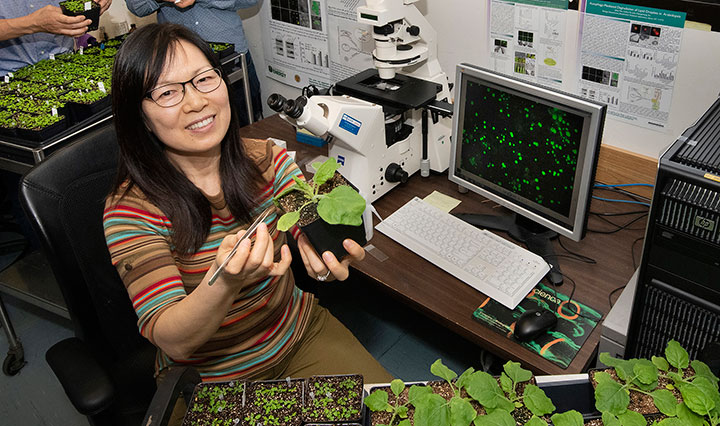
Two unanticipated discoveries by plant biochemists suggest new strategies for redirecting where plants put their carbon, a building block of energy compounds. The work could result in new strategies for growing crops for energy or other useful products. One study looked at how plants direct carbon into lignin, a component of plant cell walls. The scientists discovered details of an “electron shuttle” protein that activates the enzyme needed to build one type of lignin precursor. Changing the activity of such electron shuttle proteins could give scientists a new way to alter the makeup of lignin to make plants easier to convert to biofuels. The other study explored how plant cells “swallow” and “digest” their own worn-out components to recycle carbon stored in membrane lipids. If scientists can figure out the signaling involved in this process, called autophagy (self-eating), they might be able to block just the “digestion” step to get plant cells to hold onto to the fatty acids that make up lipids—which could then be harvested and used to make biodiesel fuel.
High-temperature Superconductivity Hunt Heats Up
If you don’t know where to look in the first place, finding materials that conduct electricity without resistance at unusually high temperatures is like finding a needle in a haystack. But this year, Brookhaven Lab scientists studying copper-oxide (cuprate) materials got two more key clues to help guide the search for such high-temperature superconductors (HTS), which could enable zero-energy-loss power transmission lines across the electric grid and other energy-saving applications. In one study, they found a high concentration of electron pairs—which are known to carry superconducting current—well above expected temperature and energy ranges. In another study, they discovered the persistence of some conductivity and possibly pairs of electrons (or electron vacancies, i.e., holes) even after superconductivity has been lost. By leveraging this new knowledge, the scientists hope to boost the superconducting powers of cuprates and find new, and perhaps better, HTS.
New AI Techniques Accelerate the Pace of Discovery
New artificial intelligence (AI) approaches developed at Brookhaven are speeding up research in chemistry, nanoscience, and more by using algorithms to sift through data faster than humans can. In one study, scientists used machine learning to extract essential information about catalytic particles from x-ray data collected under real reaction conditions. Being able to quickly translate the x-ray spectra into information about particle size, structure, and chemistry will help scientists identify the key characteristics for designing better catalysts. In a second study, scientists developed an algorithm to make “smarter” decisions during an experiment. The algorithm scans through data as it is collected at facilities like the Center for Functional Nanomaterials (CFN) and National Synchrotron Light Source II (NSLS-II) and makes autonomous decisions about what the next step should be—for example, where in a sample to take the next measurement to get the most valuable info from the available research time.
Synthesis by Assembly Encodes Greater Complexity into Nanomaterials
A high level of control is needed to engineer nanomaterials with the desired properties for particular applications. Scientists at Brookhaven Lab’s Center for Functional Nanomaterials are trying to achieve such control by developing synthesis-by-assembly techniques for organizing nanoscale components into precise architectures. For example, they developed a one-step chemical synthesis method to fabricate metallic cube-shaped nanostructures (nanocubes) with hollow interiors and holes at the corners. By changing the salt concentration of the surrounding environment, they directed these gold-silver nanowrappers to load and release DNA-coated nanoparticles in a controlled way. They also showed that coating otherwise “hard” (rigid) gold nanocubes with “soft” (flexible) DNA shells of sufficient thickness results in a kind of nanoscale sculpturing in which the nanocubes pack into an unusual never-before-seen 3-D “zigzag” pattern. The development of methods to achieve such precision assembly could lead to new materials for electronics, optics, medicine, and other applications.
Research at Brookhaven Lab is funded primarily by the DOE Office of Science. RHIC, NSLS-II and CFN are all DOE Office of Science User Facilities.
Brookhaven National Laboratory is supported by the U.S. Department of Energy’s Office of Science. The Office of Science is the single largest supporter of basic research in the physical sciences in the United States and is working to address some of the most pressing challenges of our time. For more information, visit https://www.energy.gov/science/
Follow @BrookhavenLab on Twitter or find us on Facebook
2020-16966 | INT/EXT | Newsroom




